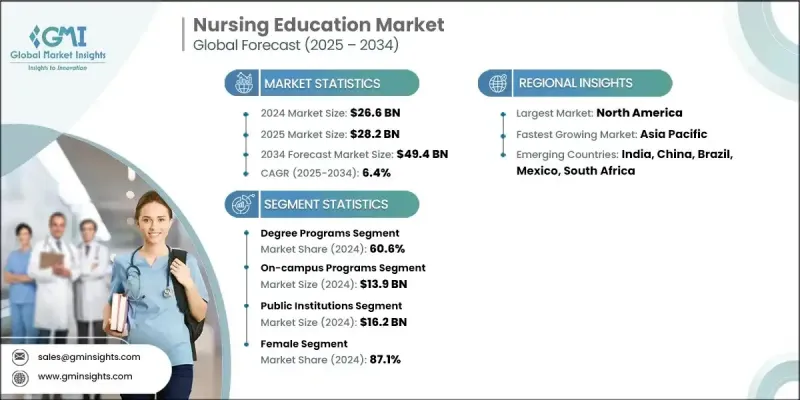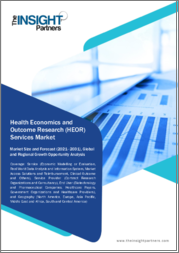
|
시장보고서
상품코드
1833689
간호 교육 시장 기회, 성장 촉진요인, 산업 동향 분석, 예측(2025-2034년)Nursing Education Market Opportunity, Growth Drivers, Industry Trend Analysis, and Forecast 2025 - 2034 |
||||||
세계 간호 교육 시장 규모는 2024년에 266억 달러로 평가되었으며, CAGR 6.4%로 성장하여 2034년에는 494억 달러에 달할 것으로 추정됩니다.

이러한 성장의 배경에는 자격을 갖춘 간호 전문가에 대한 수요 급증, 만성질환 및 생활습관병으로 인한 부담 증가, 디지털 학습 플랫폼의 급속한 발전, 세계 헬스케어 인프라의 지속적인 확장 등이 있습니다. 환자 수가 증가하고 의료 시스템이 복잡해짐에 따라 숙련된 전문 간호사의 필요성이 더욱 절실해지고 있습니다. 간호 교육은 이러한 격차를 해소하는 데 있어 핵심적인 역할을 하며, 입문 수준의 전문직과 고급 임상 역할 및 지도적 지위를 목표로 하는 전문직 모두를 지원하고 있습니다. 개발 기관은 학술적 지도, 실무 임상 교육, 첨단 기술과의 접촉을 포함한 종합적인 프로그램을 개발하고 있습니다. 전 세계적인 간호사 부족으로 인해 교육기관은 정원을 늘리고, 커리큘럼을 현대화하고, 유연한 제공 모델을 도입하여 이미 취업한 학생과 해외 거주 학생을 포함하여 더 많은 학생을 유치할 수 있도록 더욱 박차를 가하고 있습니다.
| 시장 범위 | |
|---|---|
| 시작 연도 | 2024년 |
| 예측 연도 | 2025-2034 |
| 시장 규모 | 266억 달러 |
| 예측 금액 | 494억 달러 |
| CAGR | 6.4% |
학위 프로그램 분야는 2024년 60.6%의 점유율을 차지했으며, BSN 및 MSN 학위 등 고도의 자격을 갖춘 간호사에 대한 수요 증가에 힘입어 성장세를 보이고 있습니다. 의료 시스템은 복잡한 환자 관리 및 인증 목표 달성을 위해 학위 자격을 갖춘 간호사를 점점 더 선호하고 있으며, 그 결과 학생들은 자격증 기반 경로에서 장기적인 경력 성장을 지원하는 완전한 학위 프로그램으로 전환하고 있습니다.
하이브리드 학습 분야는 2025년부터 2034년까지 CAGR 7.4%로 성장할 것으로 예측됩니다. 이러한 급격한 성장의 주요 요인은 학생들이 온라인 이론과 대면 임상 실습을 병행할 수 있는 블렌디드 형식의 인기가 높아지고 있기 때문입니다. 이러한 프로그램은 임상 능력을 희생하지 않으면서도 더 높은 유연성을 원하는 국내외 학습자들에게 어필하고 있습니다. 또한, 시뮬레이션 학습과 가상 임상 환경의 개발로 하이브리드 교육이 더욱 효과적이고 쉽게 이용할 수 있게 되었습니다.
미국 간호 교육 2024년 시장 규모는 97억 달러에 달합니다. 북미의 간호사 부족은 노동력 은퇴와 환자 수 증가로 인해 더욱 심각해지고 있습니다. 이에 대응하기 위해 미국 간호대학은 가상 시뮬레이션, AI 기반 학습 도구, 원격의료 교육 등 최신 교육 기술을 도입하고 있습니다. 교육 과정은 증거에 기반한 강력한 실무 기술과 함께 종양학, 소아과, 중환자 치료와 같은 분야의 전문성을 요구하는 의료계 고용주의 요구에 점점 더 부합하고 있습니다.
세계 간호 교육 시장의 주요 참여 기관으로는 도쿄 대학, 자미아 함다르드 대학, 킹스 칼리지 런던, 맨체스터 대학, AIIMS 뉴델리, 펜실베이니아 대학, 존스 홉킨스 대학, 캘리포니아 대학, 듀크 대학, 연방 보건 과학 대학, 플로리다 대학, 홍콩 중문 대학, 알아즈하르 대학, 카타르 대학, 싱가포르 국립 대학 등이 있습니다. 주요 개발 기관들은 지속적인 커리큘럼 개발, 하이브리드 및 온라인 교육 확대, 디지털 시뮬레이션 연구소에 대한 투자를 통해 경쟁력을 강화하고 있습니다. 이들 학교는 의료 서비스 제공자와 적극적으로 협력하여 학생들을 위한 강력한 임상 실습처를 확보하여 진화하는 업계의 요구에 부응하고 있습니다.
목차
제1장 조사 방법과 범위
제2장 주요 요약
제3장 업계 인사이트
- 생태계 분석
- 업계에 대한 영향요인
- 성장 촉진요인
- 헬스케어 서비스 수요 증가
- 등록 간호 직원의 부족
- 세계화와 국제 기관과의 제휴
- 업계의 잠재적 리스크와 과제
- 규제 및 인증 요건
- 시장 기회
- 농촌 지역 시장 진입 전략
- 온라인 간호 교육의 호기를 맞이한 국가
- 성장 촉진요인
- 성장 가능성 분석
- 규제 상황
- 북미
- 유럽
- 아시아태평양
- 간호사 부족 전체에 영향을 미치는 요인
- 노동력 인구통계와 번아웃 증후군
- 교육 능력과 제도적 장벽
- 온라인 간호 교육의 이점
- 시장 진입과 성장 기회
- 세계적인 간호 교육 분야의 파트너십 기회
- 현재 및 조만간 심각한 간호사 부족에 직면할 지역을 대상으로 한다
- 간호 교육 프로그램의 테크놀러지 채용
- Porters 분석
- PESTEL 분석
- 주요 뉴스와 대처
제4장 시장 추정과 예측 : 교육 제공별, 2021-2034
- 주요 동향
- 학위 프로그램
- 전문 분야
- 증명서/졸업 증서 프로그램
제5장 시장 추정과 예측 : 교육 제공 형태별, 2021-2034
- 주요 동향
- 캠퍼스내 프로그램
- 하이브리드 프로그램
- 온라인 프로그램
제6장 시장 추정과 예측 : 기관 유형별, 2021-2034
- 주요 동향
- 공적 기관
- 사립 기관
제7장 시장 추정과 예측 : 성별, 2021-2034
- 주요 동향
- 여성
- 남성
제8장 시장 추정과 예측 : 지역별, 2021-2034
- 주요 동향
- 북미
- 미국
- 캐나다
- 유럽
- 독일
- 영국
- 프랑스
- 스페인
- 이탈리아
- 네덜란드
- 아시아태평양
- 중국
- 일본
- 인도
- 호주
- 한국
- 라틴아메리카
- 브라질
- 멕시코
- 아르헨티나
- 중동 및 아프리카
- 남아프리카공화국
- 사우디아라비아
- 아랍에미리트
제9장 교육기관
- AIIMS, 뉴델리
- 듀크 대학
- 연방 보건 과학 대학
- 쟈미아·함다드
- 젼즈·호프킨스 대학
- 킹스 컬리지 런던
- 싱가포르 국립대학
- 카타르 대학
- 홍콩안문대학
- 도쿄대학
- 알·아즈 헐 대학
- 캘리포니아 대학
- 플로리다 대학
- 맨체스터 대학
- 펜실베니아 대학
The Global Nursing Education Market was valued at USD 26.6 billion in 2024 and is estimated to grow at a CAGR of 6.4% to reach USD 49.4 billion by 2034.

This growth is driven by a surge in demand for qualified nursing professionals, the increasing burden of chronic and lifestyle-related illnesses, rapid developments in digital learning platforms, and the ongoing expansion of healthcare infrastructure worldwide. As patient volumes rise and healthcare systems grow more complex, the need for skilled and specialized nurses has become more urgent. Nursing education has become central to bridging this gap, supporting both entry-level professionals and those pursuing advanced clinical roles or leadership positions. Institutions are developing comprehensive programs that include academic instruction, hands-on clinical training, and exposure to advanced technologies. The global nursing shortage is further pushing educational bodies to scale capacity, modernize curricula, and introduce flexible delivery models to attract more students, including those already in the workforce or living abroad.
| Market Scope | |
|---|---|
| Start Year | 2024 |
| Forecast Year | 2025-2034 |
| Start Value | $26.6 Billion |
| Forecast Value | $49.4 Billion |
| CAGR | 6.4% |
The degree programs segment held a 60.6% share in 2024, fueled by growing demand for nurses with advanced credentials such as BSN or MSN degrees. Healthcare systems increasingly prefer degree-qualified nurses for complex patient care and to achieve accreditation goals, which is steering students away from certificate-based pathways toward full degree programs that support long-term career growth.
The hybrid learning segment is projected to grow at a CAGR of 7.4% from 2025 to 2034. This surge is largely attributed to the rising popularity of blended formats that allow students to combine online theory with in-person clinical practice. These programs appeal to both domestic and international learners seeking greater flexibility without compromising on clinical competency. Developments in simulation-based learning and virtual clinical environments have also made hybrid education more effective and accessible.
U.S. Nursing Education Market generated USD 9.7 billion in 2024. The shortage of nurses in North America is being compounded by a retiring workforce and rising patient loads. To address this, U.S. nursing schools are incorporating the latest instructional technologies, including virtual simulations, AI-based learning tools, and telehealth training. Curricula are increasingly aligning with the needs of healthcare employers who demand specialization in areas such as oncology, pediatrics, and critical care, alongside strong evidence-based practice skills.
Major participants in the Global Nursing Education Market include University of Tokyo, Jamia Hamdard, King's College London, University of Manchester, AIIMS New Delhi, University of Pennsylvania, Johns Hopkins University, University of California, Duke University, Federal University of Health Sciences, University of Florida, The Chinese University of Hong Kong, University of Al-Azhar, Qatar University, and the National University of Singapore. Leading institutions are enhancing their competitiveness through continuous curriculum development, expansion of hybrid and online offerings, and investments in digital simulation labs. These schools are actively partnering with healthcare providers to secure strong clinical placements for students and stay aligned with evolving industry needs.
Table of Contents
Chapter 1 Methodology and Scope
- 1.1 Market scope and definitions
- 1.2 Research design
- 1.2.1 Research approach
- 1.2.2 Data collection methods
- 1.3 Data mining sources
- 1.3.1 Global
- 1.3.2 Regional/country
- 1.4 Base estimates and calculations
- 1.4.1 Base year calculation
- 1.4.2 Key trends for market estimation
- 1.5 Primary research and validation
- 1.5.1 Primary sources
- 1.6 Forecast model
- 1.7 Research assumptions and limitations
Chapter 2 Executive Summary
- 2.1 Industry 3600 synopsis
- 2.2 Key market trends
- 2.2.1 Regional trends
- 2.2.2 Educational offerings trends
- 2.2.3 Educational delivery mode trends
- 2.2.4 Institution type trends
- 2.2.5 Gender trends
- 2.3 CXO perspectives: Strategic imperatives
- 2.3.1 Key decision points for industry executives
- 2.3.2 Critical success factors for market players
- 2.4 Future outlook and strategic recommendations
Chapter 3 Industry Insights
- 3.1 Industry ecosystem analysis
- 3.2 Industry impact forces
- 3.2.1 Growth drivers
- 3.2.1.1 Rising demand for healthcare services
- 3.2.1.2 Shortage of registered nursing staff
- 3.2.1.3 Globalization and collaboration with international institutes
- 3.2.2 Industry pitfalls and challenges
- 3.2.2.1 Regulatory and accreditation requirements
- 3.2.3 Market opportunities
- 3.2.3.1 Rural areas market entry strategies
- 3.2.3.2 High-opportunity countries for online nursing education
- 3.2.1 Growth drivers
- 3.3 Growth potential analysis
- 3.4 Regulatory landscape
- 3.4.1 North America
- 3.4.2 Europe
- 3.4.3 Asia Pacific
- 3.5 Factors influencing the overall nursing shortage
- 3.5.1 Workforce demographics and burnout
- 3.5.2 Educational capacity and systemic barriers
- 3.6 Advantages of online nursing education
- 3.7 Market entry and growth opportunities
- 3.7.1 Partnership opportunities in global nursing education
- 3.7.2 Target regions with severe nursing shortages in the current and near future
- 3.7.3 Adoption of technology in nursing education programs
- 3.8 Porter's analysis
- 3.9 PESTEL analysis
- 3.10 Key news and initiatives
Chapter 4 Market Estimates and Forecast, By Educational Offerings, 2021 - 2034 ($ Mn)
- 4.1 Key trends
- 4.2 Degree programs
- 4.3 Specializations
- 4.4 Certificate/diploma programs
Chapter 5 Market Estimates and Forecast, By Educational Delivery Mode, 2021 - 2034 ($ Mn)
- 5.1 Key trends
- 5.2 On-campus programs
- 5.3 Hybrid programs
- 5.4 Online programs
Chapter 6 Market Estimates and Forecast, By Institution Type, 2021 - 2034 ($ Mn)
- 6.1 Key trends
- 6.2 Public institutions
- 6.3 Private institutions
Chapter 7 Market Estimates and Forecast, By Gender, 2021 - 2034 ($ Mn)
- 7.1 Key trends
- 7.2 Female
- 7.3 Male
Chapter 8 Market Estimates and Forecast, By Region, 2021 - 2034 ($ Mn)
- 8.1 Key trends
- 8.2 North America
- 8.2.1 U.S.
- 8.2.2 Canada
- 8.3 Europe
- 8.3.1 Germany
- 8.3.2 UK
- 8.3.3 France
- 8.3.4 Spain
- 8.3.5 Italy
- 8.3.6 Netherlands
- 8.4 Asia Pacific
- 8.4.1 China
- 8.4.2 Japan
- 8.4.3 India
- 8.4.4 Australia
- 8.4.5 South Korea
- 8.5 Latin America
- 8.5.1 Brazil
- 8.5.2 Mexico
- 8.5.3 Argentina
- 8.6 Middle East and Africa
- 8.6.1 South Africa
- 8.6.2 Saudi Arabia
- 8.6.3 UAE
Chapter 9 Educational Institutes
- 9.1 AIIMS, New Delhi
- 9.2 Duke University
- 9.3 Federal University of Health Sciences
- 9.4 Jamia Hamdard
- 9.5 Johns Hopkins University
- 9.6 Kings College London
- 9.7 National University of Singapore
- 9.8 Qatar University
- 9.9 The Chinese University of Hong Kong
- 9.10 The University of Tokyo
- 9.11 University of Al-Azhar
- 9.12 University of California
- 9.13 University of Florida
- 9.14 University of Manchester
- 9.15 University of Pennsylvania



















